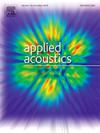Low complexity DOA estimation based on weighted noise component subtraction for smart-home application
IF 3.4
2区 物理与天体物理
Q1 ACOUSTICS
引用次数: 0
Abstract
In smart home applications, accurate direction of arrival (DOA) estimation of sound sources is essential for beamforming and product interaction features. However, domestic environments often suffer from reverberation, noise, and interference, making DOA estimation challenging, especially when human voices interfere. This paper proposes a lightweight, noise-and-interference-resistant DOA method based on the SRP-PHAT algorithm. By leveraging spectral subtraction and the wake-up-to-recognize process, the method estimates the noise SRP-PHAT spectrum during non-wake periods. It then derives the mixed SRP-PHAT spectrum and subtracts the noise component to obtain a clean SRP-PHAT spectrum. Recognizing the sparsity and uneven energy distribution of speech signals, the method uses timestamps from the wake word engine to estimate the target source mask and apply weighting to the clean SRP-PHAT spectrum. Extensive experiments on simulated and real-recorded data show that this method significantly enhances DOA performance in complex scenarios.
求助全文
约1分钟内获得全文
求助全文
来源期刊

Applied Acoustics
物理-声学
CiteScore
7.40
自引率
11.80%
发文量
618
审稿时长
7.5 months
期刊介绍:
Since its launch in 1968, Applied Acoustics has been publishing high quality research papers providing state-of-the-art coverage of research findings for engineers and scientists involved in applications of acoustics in the widest sense.
Applied Acoustics looks not only at recent developments in the understanding of acoustics but also at ways of exploiting that understanding. The Journal aims to encourage the exchange of practical experience through publication and in so doing creates a fund of technological information that can be used for solving related problems. The presentation of information in graphical or tabular form is especially encouraged. If a report of a mathematical development is a necessary part of a paper it is important to ensure that it is there only as an integral part of a practical solution to a problem and is supported by data. Applied Acoustics encourages the exchange of practical experience in the following ways: • Complete Papers • Short Technical Notes • Review Articles; and thereby provides a wealth of technological information that can be used to solve related problems.
Manuscripts that address all fields of applications of acoustics ranging from medicine and NDT to the environment and buildings are welcome.
 求助内容:
求助内容: 应助结果提醒方式:
应助结果提醒方式:


